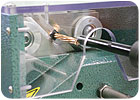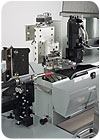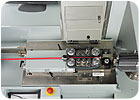
Tabletop machines, like the 77E, strip thick wire and cable with precision. Shown is the bundled copper conductor of a 1/0 AWG wire that’s been stripped of its outer jacket. Photo courtesy Carpenter Manufacturing Co. Inc.
Extreme for some is mainstream for others. Cultural examples include sports, music and reality TV shows. In the wire processing industry, extreme for some assemblers means products like very thin wire and very thick wire or cable.
Six months ago, ASSEMBLY discussed the latest technologies and uses for wire sized 26 AWG and smaller. Now, we’ll look at the opposite end of the spectrum and focus on the challenges assemblers face when processing wire and cable sized 1/0 AWG and larger.

A heavy-duty cutter
head is required to cut and strip thick cable and wire. Photo courtesy Artos
Engineering Co.
What's Inside: One or Many
Wire measuring 1/0 AWG or larger has an outer jacket and internal wire core of many noninsulated strands. The conductor diameter of 1/0 AWG wire is 8.25 millimeters.This thick wire is not to be confused with similar-size cable having an outer jacket, inner shield and internal wire core that’s either a bundle of many noninsulated strands or several insulated conductors separated by a filler material. In the latter case, each conductor consists of several wire strands and a different color insulation. The conductor wires may be the same thickness or different thicknesses. The insulation of each conductor also can be different, depending on the current going through it.
Thick wire tends to be used in power applications, such as welding and automotive assembly. Thick cable tends to be used in low-power and signal applications.
“In a 1/0 cable that meets U.S. military spec, typical stranding is 1,045 strands of 30 AWG wire, whereas specialty cable in a 1 aught may have more than 3,300 strands of 36-gauge wire,” says Dave Lash, an engineer with LaBarge Inc., an electronic manufacturing services company. LaBarge makes custom cables for large military and aerospace equipment, such as tanks, airplanes and submarines.

The
Kappa 321 precisely strips smaller wires within a thick, multiconductor cable.
Each conductor is a different color. Photo courtesy Komax.
The Tabletop Approach
Most wire and cable 1/0 and larger is processed on tabletop equipment, since thick wire and cable tends to be used in low-volume, high-mix applications. Assemblers typically use individual or combination machines that perform prefeeding, stripping, cutting and crimping. The machines are often arranged in a workcell. Depending on the unit and supplier, these machines are either electric, pneumatic or manually powered.The main challenge when feeding thick wire and cable is to keep it straight. Both products are very stiff and often twisted, making it difficult to achieve straightness. Perfectly round wire and cable feed better than nonconcentric ones. Prefeeders overcome this problem by limiting tensile stress, ensuring a steady flow of wire into the processing machine, and preventing or removing kinking or bending.
“Prefeeders are as important as the processing machines,” says Alan Sorenson, director of sales and marketing for Carpenter Manufacturing Co. Inc.
Some assemblers that process small amounts of thick wire or cable prefer feeding it manually into cutting, stripping and crimping machines. Whether fed manually or with a prefeeder, the wire or cable should have enough stiffness so it doesn’t drag across the ground.
Wire or cable is mounted to the prefeeder on a sturdy wooden spool. Spool capability varies greatly. Some units can handle spools of 4/0 AWG wire weighing up to 1,300 pounds. Prefeeders also are available with a loop control system and sensors that activate pulleys to move the wire or cable smoothly into cutting and stripping machines.
Measuring thick wire or cable poses no extra challenges for processing equipment. Standard tabletop machines measure it with either a length encoder or a run-out detector.
Thick wire or cable can be cut to any length with tabletop machines. Some units cut guillotine-style, while others slice across the wire or cable.
Tabletop units can strip wire or cable to a maximum length of 6 inches. Stripping the wire or cable’s outer jacket can be a challenge when it is not uniformly thick. Assemblers must be careful to cut through it without damaging any internal wire strands or insulated conductors.
When stripping internal conductors, the challenge is to precisely strip one at a time. This is best done by spreading the conductors as much as possible prior to placing them in the stripping position.
Some models provide touch-screen interfaces and OD and depth guides to help operators strip precisely. “Some cut-and-strip combination machines feature a detector that measures the wire or cable’s diameter and cross section, then determines the way-back setting and where the blade should start from to control slit quality,” says André Gilbraith, product manager for Komax.
Tabletop machines use various blade types to cut through the insulation, including twin, V and standard razor blades. Depending on the machine, the insulation may be removed automatically by the machine or manually by the operator.
If batch volume is very low, another option is to use specially designed hand tools.
Crimping a terminal to thick wire or cable requires a large press. One supplier makes a crimping machine with a maximum force of 20 kilonewtons. Operators can control the crimping process through use of foot pedals or manual controls.
Some machines only perform crimping, while others perform both stripping and crimping.
“A combination unit offers more accurate crimping than two separate machines because it features a sensor that activates tooling to automatically crimp the wire in place,” says Thomas H. Stein, president of Tomken Industries Inc.
As with standard and small wire, terminating large wire or cable involves the ongoing challenge of avoiding “strands out,” a term that refers to strands that are neither cut off nor in the crimp area.

Thick wire and cable
are often stiff and twisted when received by assemblers. Both products must be
straight when fed into cutting and stripping machines. Photo courtesy Artos
Engineering Co.
Sometimes It's Automatic
Some suppliers offer fully automated processing machines that cut, strip and crimp thick wire and cable-but they cost about five times as much as a tabletop unit. “Automated machines serve a narrow part of the market,” says John Olsen, president of Artos Engineering Co. “They are used more for point-to-point applications, rather than making wire harnesses.”Automated machines require a prefeeder to keep the wire straight. However, they can handle much larger reels (up to 5,000 pounds) than a tabletop unit and somewhat larger wire-up to 16 millimeters in diameter. (The largest size on the AWG scale, 4/0, is 11.7 millimeters in diameter.)
Automated machines can cut and strip thick wire to any length. They feature programmable settings for wire and strip length and diameter, as well as for functions like end-of-core position and gripper pressure. These machines have much greater gripping force and proportionately sized servomotors.
Automated machines also allow high-volume operations and let assemblers quickly change wire guides and assemblies.
Like their semiautomatic tabletop cousins, fully automatic crimping machines for thick wire and cable are much larger than crimping machines for thinner wire. One supplier offers a tabletop machine with a crimping force of 2,000 to 3,000 pounds, and an automated machine with a maximum crimping force of 20,000 pounds. Crimp-force monitoring is a useful option on most automated machines.
The most common users of automated processing machines are OEMs and major suppliers to the automotive industry. One such user is Delphi Packard Electrical/Electronic Architecture, which uses both commercially available and customized automated equipment to process thick cable.
“We use equipment with a ‘smart camera’ vision system that lets us automatically terminate multiple conductors within a thick cable bundle,” says Jim Miller, manager of process engineering. After the processing system moves the conductors into place, the camera determines insulation color in terms of red, yellow and green. The conductors are then terminated. Miller does acknowledge that it takes a very high volume to pay for this kind of processing system.
